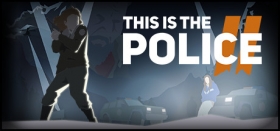
This Is The Police 2 Review
This Is The Police 2 is a game that feels like it doesn’t need to exist. The first title was one of the better games about the fuzz, weaving a compelling story about police corruption into surprisingly deep management sim gameplay. However, This Is The Police 2 is a case of two steps forward, one step back. For every interesting new feature introduced in the sequel, outstanding issues from the first game still haven’t been addressed, and in some areas it’s actually worse.
In terms of presentation, This Is The Police 2 retains the simple art style and minimal sound design of the first game, but adds an additional level of polish by introducing animated cutscenes, increasing the level of detail in the game world, and adding some additional sound effects and licensed music to the mix. Superb voice acting from John St. John (the voice of Duke Nukem) and Sarah Hamilton (April Ryan from The Longest Journey) brings the two leads to life, and even the support characters are voiced well. The UI has also received a visual overhaul, though that doesn’t translate to gameplay improvements (more on that later).

The narrative follows chronologically from the first game, with Jack Boyd returning alongside a cast of new characters in the sleepy backwater town of Sharpwood. The writing and narrative are serviceable, but they lack the poignancy, subtlety, and pace that made This Is The Police such an engrossing story. Dialogue is often overly verbose, and the main plotline becomes such a confusing mess that after a while you’ll likely just give up trying to follow it. The themes the game addresses, such as sexism, justice, and pragmatism are handled with the subtlety of a sledgehammer. It’s honestly hard to believe that it’s written by the same people as the first game, as This Is The Police’s story was one of its biggest strengths.
By far the biggest changes are in the gameplay department, but frustratingly, it’s also here where some of the biggest issues from This Is The Police remain. The management side of gameplay remains largely unchanged: You’ll be spending most of your time allocating officers to respond to various crimes and choosing how they react to the situation, but that’s not as easy as it sounds. Each call out requires a minimum level of “Professionalism” (basically the game’s XP system for officers), and this is a concrete threshold (as opposed to say a percentage chance of success based on whether they fall short of, meet, or exceed the required Professionalism). Layered on top of this are officer traits such as their willingness to work with the other members of the force, how much they like you, and skills such as strength and shooting accuracy.

This means that crimes will occur which you’re simply unequipped for, whether it’s because you don’t have the required Professionalism, or because you need a skilled negotiator but your only officer who can respond to the call would rather shoot first and ask questions later. This wouldn’t be such an issue if Sharpwood didn’t have a crime rate that would make a New Yorker blush. Honestly, it’s as if everyone in this town is a criminal. The absurd difficulty level is one of the major criticisms that was levelled at This Is The Police, and the sequel seems to have responded by saying “Hold my beer.” Further, the game seems unwilling to provide a quick, clear way of seeing all the important information you need when sending out a squad to a crime. For example, often you’ll only become aware that one officer dislikes another when you go to pair them up. For a management sim, it’s frustrating that basic quality of life features of the genre are missing.
The largest addition to gameplay is the inclusion of random XCOM style turn-based missions. Dealing with anything from hostage situations to bank robberies, you’ll be commanding your best officers through procedurally generated environments and choosing whether to apprehend the suspects or use deadly force. However, while these encounters do add some additional flavour to the campaign, they lack the depth and tension of their obvious inspiration, and they don’t do enough to mitigate the aforementioned complaints.

At the end of the day, This Is The Police 2 is not a bad game by any stretch of the imagination. It’s just not a particular good one either. Its frustrating design choices, absurd difficulty, and limp story and writing make it feel like a weak sequel that doesn’t build enough on its predecessor’s foundations to warrant its existence.
This Is the Police 2 (Reviewed on Windows)
The game is average, with an even mix of positives and negatives.
A competent sequel that adds some neat touches, but doesn't fix enough of the first game's problems.








COMMENTS